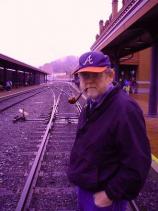Far As the Eye Can See
Review
Far As the Eye Can See
Characters like the enigmatic yet relatable Bobby Hale are a real prize in literature. In Robert Bausch’s superb western, FAR AS THE EYE CAN SEE, we get to know the man who has created various aliases to re-enlist in the army and earn the enlistment bonus. Here the allure of his character begins. Bobby is a man whose understanding comes from exploring others while remaining mostly objective, yet at the same time also taking strong actions when necessary.
FAR AS THE EYE CAN SEE, which is set in a small pocket of time following the Civil War, grabs you immediately with an incredible prologue. We follow Bobby as he ventures into Indian territory, travels with the larger-than-life Big Tree, and heads to Bozeman, Montana, where he meets a woman who teaches him that no one has to go through life alone. Bobby is a constant rogue who ventures off swearing to return, but his unpredictable trigger --- much like the west itself --- alters his plans in unforeseen ways.
"Expertly told, with the storytelling quality that keeps one eager and excited while also relaying a gripping and engaging tale, FAR AS THE EYE CAN SEE is at times humorous, violent and realistic, brutal and unpredictable but always engaging."
Bausch’s novel isn’t exactly a love story --- it is more the story of desire, and understanding humanity in the heart of the wild and unpredictable west. He delivers some fine insights into the human heart. After Bobby returns to search for his love, Eveline, as he is torn between two women, some of the freshest concepts emerge. He recounts to himself: “It’s a tragic kind of world we find ourselves in, all the time looking for some way to have what we want, hoping for nothing but a reason to hope. It ain’t easy being on this earth for none of us --- because we know about future things and what we want or don’t want, or we can be pretty damn confused by both wanting and not wanting.”
FAR AS THE EYE CAN SEE is a superb western with bold ideas, but it is also daring in its ability to build fresh concepts while maintaining the tried-and-true dynamic of humanity emerging within individuals through war. Some of the most prolific scenes emerge when Bobby shoots the young girl Ink and says, “You can’t possibly want to travel with me, I’m white.” It’s fairly obvious that the characters are guiding themselves beyond race and towards helping one another, yet they stay cautious due to societal norms. The book shatters these notions between characters, testing their beliefs on a large scale. At times it’s simply man against man as we see white men do awful things to Indians, Indians scalp white men, and white men hang other white men, but we also see these different races treat each other hospitably and with good nature. Bausch is suggesting here that humanity itself has the propensity to do both great good and great evil, using race and war as a catalyst and the tumultuous west as his setting.
Expertly told, with the storytelling quality that keeps one eager and excited while also relaying a gripping and engaging tale, FAR AS THE EYE CAN SEE is at times humorous, violent and realistic, brutal and unpredictable but always engaging. Bausch has delivered a page-turning novel that makes readers think and care deeply for its characters, who act out of real fears and desires. The heart of the book is naturally with Bobby Hale, but one also becomes engrossed with the mythos of the west, learning from those who act out of fear and understanding the consequences of a land that was as ruthless as any. FAR AS THE EYE CAN SEE teaches us that humanity is what helped it survive.
Reviewed by Stephen Febick on November 26, 2014
Far As the Eye Can See
- Publication Date: November 4, 2014
- Genres: Fiction, Historical Fiction, Western
- Hardcover: 320 pages
- Publisher: Bloomsbury USA
- ISBN-10: 1620402599
- ISBN-13: 9781620402597











